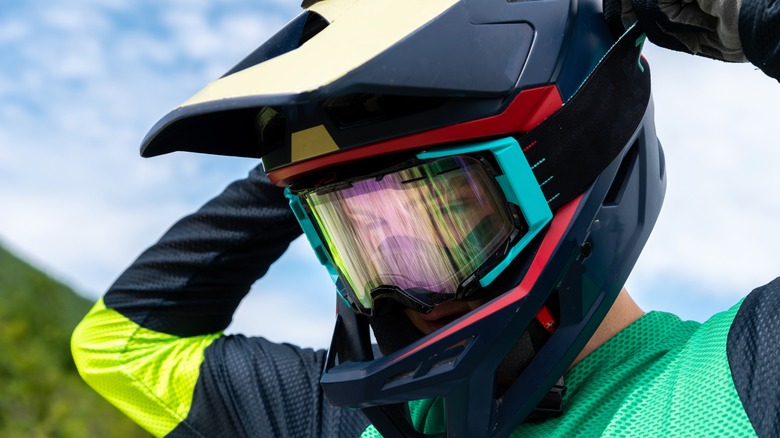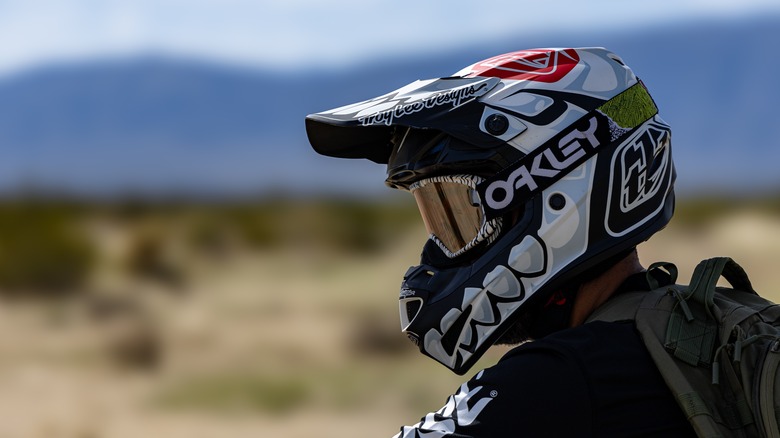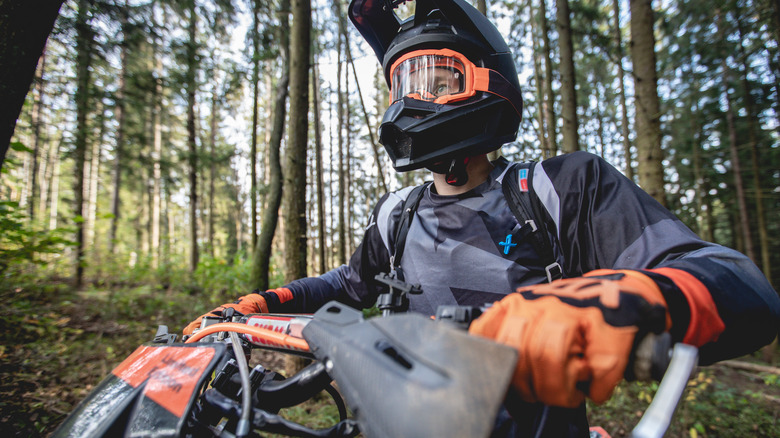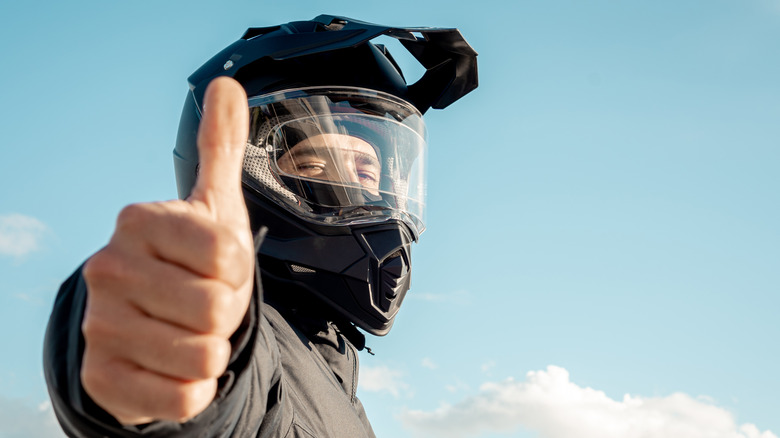Why Are Dirt Bike Helmets Shaped Differently From Motorcycle Helmets?
The very first thing you learn when operating any kind of two-wheeled transport — be it a bicycle, a motorcycle, or a dirt bike — is that a helmet is absolutely mandatory at all times. Nobody rides without a brain bucket, full stop. A helmet is necessary to provide you with the extra layer of safety and defense that you otherwise lose from driving an open-air vehicle. However, the precise kind of helmet that you need to wear varies depending on the kind of vehicle you're riding.
A bicycle helmet only covers the top of the head, a motorcycle helmet needs to cover at least the top and back of the head, and a dirt bike helmet needs to cover the entire head. On that last matter, dirt bike helmets maintain a distinctive profile from their contemporaries, with a visor built into the top and a large, jutting chin guard on the bottom. Besides giving motocross riders a signature look, is there a reason for these idiosyncratic design choices? Of course there is, and to nobody's surprise, it's all about safety while riding, particularly on the rough, uneven terrain you would expect to see on a dirt track.
Dirt bike helmets always cover the entire face and head
If you were riding on a regular paved-road-ready motorcycle, you'd need to wear a proper helmet. However, while the signature design of a motorcycle crash helmet covers the whole face and head, the full covering technically isn't necessary. Three-quarter and half helmets are both legal and offer sufficient protection while out on the highway. Many riders opt for these designs for their increased comfort and visibility.
Dirt bike helmets, on the other hand, absolutely must cover the entire face and head, no exceptions. Riding on a motocross course kicks up a massive quantity of dust, dirt, and small debris, and all of it has the potential to fly into a rider's mouth, nose, and eyes. Putting aside the general grossness factor, having a pebble fly into your eye while you're in the midst of navigating uneven terrain is borderline guaranteed to send you tumbling off your bike and off the track. This is why dirt bike helmets need to cover your entire face and head, to provide full protection from the elements. Additionally, the visor atop the helmet helps to keep sunlight out of the rider's eyes, while the extended jaw section provides some extra cushioning in the event of a tumble.
Dirt bike helmets have extra space for ventilation and attaching goggles
While a dirt bike helmet needs to cover your entire face for safety reasons, are there any additional reasons for that large, jutting section on the bottom and the visor on the top? Of course there are, and it's another important one: ventilation. Motocross riding is a highly physical sport — not to say regular motorcycle riding isn't, of course, but navigating hills and pits definitely takes more out of you. The extra space next to your mouth and nose helps to keep air circulating inside the helmet, making it easier to breathe while on the track. The visor limits the wind in the rider's face so fresh air can flow more easily. Dirt bike helmets are usually made of lighter materials to offset the increased space, though the materials used, such as carbon fiber and polycarbonate, don't skimp on defensive power.
It's for a similar reason that most motocross helmets don't have built-in visors, instead opting for open spaces where riders can attach their own safety goggles. While visors are nice on the highway for keeping the wind out of your eyes, a solid sheet of plastic isn't great for ventilation. If you tried to wear a full motorcycle helmet on a motocross track, the visor would swiftly fog up from your breathing. Using separate goggles instead keeps your eyes protected while also preventing your breath from fogging them up.
Dirt bike helmets should not be used for regular riding
Since dirt bike helmets have so many nifty features going for them, you may be tempted to dump your regular motorcycle helmet and just use a dirt bike helmet for your highway rides. This, however, would be inadvisable.
The reason that regular motorcycle helmets are smooth and rounded is that, in the event of an accident, they (and your head in them) will glide cleanly along the flat ground without catching on anything. If you crashed on the highway with a dirt bike helmet on, the elongated jaw section and visor would almost definitely catch on the grooves of the road, which would be bad news for your head and neck, to say the least.
Much like how there are dual sport motorcycles, there are dual sport helmets that can serve the purposes of both motocross and regular riding. These helmets provide the rounded protection needed for road riding, but also offer greater ventilation and the option to attach goggles for dirt-biking needs. If you're planning on going pro in either sphere, a dedicated helmet would be better, but if you're a casual rider in both, then a dual sport helmet should be fine.



